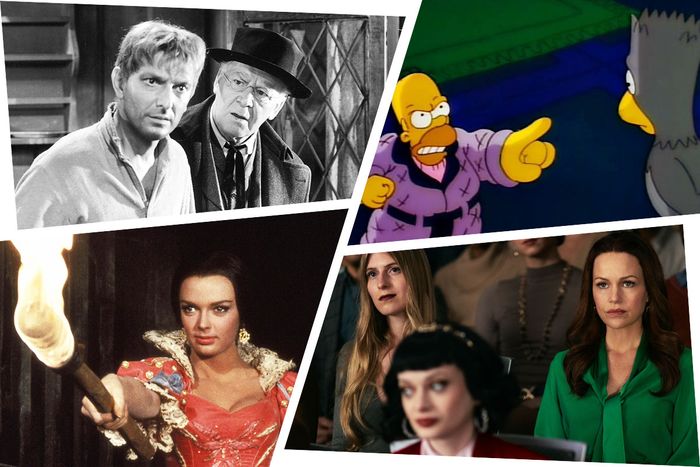
In the past few years, director Mike Flanagan has embarked on a spooky adaptation tour of sorts. He tackled Stephen King with Gerald’s Game and Doctor Sleep, received massive amounts of praise for his treatment of Shirley Jackson’s The Haunting of Hill House, turned Henry James’s The Turn of the Screw into The Haunting of Bly Manor, and even took a stab at young-adult author Christopher Pike’s The Midnight Club. On October 12, Netflix audiences will get to see how he handles Edgar Allan Poe with the miniseries The Fall of the House of Usher.
This latest adaptation is notable due to the sprawling legacy Poe left behind. The author is essentially the first son of American horror and detective literature, and his stories and poems influenced other writers like James and H.P. Lovecraft. Poe’s work has been featured in horror cinema for almost as long as the genre has existed. If you’re looking to experience it onscreen before the upcoming Netflix show, you’re certainly not lacking in the way of solid offerings. From the early silent-film era to our favorite mean yellow family, here are ten adaptations that best exemplify Poe’s revolutionary work in the realm of the macabre.
The Plague in Florence (1919)
Written by Austrian filmmaker Fritz Lang, who went on to direct Metropolis and M, The Plague of Florence adapts Poe’s The Masque of the Red Death. Known for its personification of a plague as a mysterious figure, the short story was first published just a few years after a cholera pandemic tore across the globe claiming hundreds of thousands of lives. Most film adaptations place the story in medieval times, however, and Lang goes one step further with his silent film by rendering the plague as a woman who seems to tempt society as it perishes around her. We’re so consumed by lust and greed, Lang proposes, that death doesn’t even have to prey on us — we simply fall to it.
Murders in the Rue Morgue (1932)
With adaptations of Frankenstein and Dracula, Universal Pictures established itself as the go-to studio for American horror films in the early 1930s, and it would soon include Poe’s work in its stable of shocks with Murders in the Rue Morgue. This wasn’t the first American adaptation of Poe’s work; among others, D.W. Griffith filmed The Tell-Tale Heart in 1914, and the titular Phantom dressed as the Red Death for a bit in Universal’s first Phantom of the Opera film in 1925. Murders of the Rue Morgue, though, capitalizes on Poe at his outlandishly ghoulish best.
Centered on the story of a mad doctor who kidnaps women and injects them with ape blood to create a proper mate for his gorilla henchman, the film expands Poe’s short story about a killer orangutan to give leading man Bela Lugosi more creepy things to do. Fresh off Dracula, Lugosi would soon be shoved into every evil doctor/scientist role Hollywood had to offer, and Rue Morgue captures him at the height of his scenery-chewing aplomb. Director Robert Florey, having been passed over to helm Frankenstein, fills Rue Morgue with touches of German Expressionism, and the movie ends with an ape being shot and falling from a tall building — one year before King Kong.
The Black Cat (1934)
As Rue Morgue made abundantly clear, Poe’s work was ripe for narrative extrapolation. The Black Cat has little to do with his short story of the same title aside from the appearance of a black cat and Poe’s name featuring prominently on the poster. Instead, nestled inside a tale about a mysterious house built in a ruined World War I fort and the plans for revenge that go on there, it provided a chance for Universal Pictures to pit its two horror icons against each other — Lugosi takes on Boris Karloff here with the Frankenstein actor now playing a very effective serial murderer and cult leader.
Though it moves Poe’s story outside the context of a man driven mad by a certain kind of cat, it decidedly takes advantage of the author’s consistent emotional thematics. The whole thing reeks of paranoia and of an untrustworthy world looming above to swallow you whole. It even allows Lugosi, who was far more well known for his otherworldly screen presence, to tap into a pathos he was rarely afforded in his career. And Karloff obviously relishes his malice, grinning and puppeteering the emotions of everyone around him just as Poe did with his readers: “Did you hear that, Vitus? The phone is dead. Even the phone is dead.”
The Tell-Tale Heart (1941)
While Universal flooded cinemas with horror films throughout the 1930s (the studio released a third loose Poe adaptation with The Raven in 1935), MGM stuck to its dramas and comedies. Horror had burned it a few times, typically thanks to director Tod Browning, who turned in the controversial Freaks. However, when it did produce horror — like 1941’s Dr. Jekyll and Mr. Hyde (which was nominated for three Academy Awards) — it was something special. This short, faithful adaptation of The Tell-Tale Heart, made to play in theaters before the feature film screened, is often stunning to look at.
Through a concoction of slow zooms and desperate close-ups, the feeling of guilt in the film becomes inescapable. Combined with its excellent sound design, this is a Poe adaptation that thrives purely on the author’s work.
House of Usher (1960)
The most famous Poe adaptations are likely those directed by Roger Corman, who in 1960 was quickly on his way to becoming a B-movie wunderkind. Poe’s stories, already in the public domain, were relatively cheap to adapt even with Corman’s ambitious set designs and the hiring of notable writers like novelist Richard Matheson (I Am Legend) to pen the scripts. House of Usher would prove they had major box-office potential, too.
The glue that held Corman’s films together was Vincent Price, a performer who, as Universal honed with Lugosi three decades earlier, could shift between menace and camp with ease. Here, Price taps into the former, playing one sibling in the cursed Usher family who is doomed to sink with his mansion in the death grip of his mad sister. Poe adaptations were generally black-and-white affairs before House of Usher arrived in gorgeous color, perfectly capturing the rotten setting and the bizarre characters who inhabit it.
The Pit and the Pendulum (1961)
In retrospect, House of Usher seems like a warm-up for The Pit and the Pendulum: Matheson returns as the screenwriter, and Price gets even more chances to luxuriate in macabre abandon (he plays two roles!). Corman’s dungeon set pieces are a wonderful combination of construction and matte paintings, and if you came to the theater to see the titular torture device, Corman didn’t disappoint. To match Price, the director hired Barbara Steele, who had starred in Mario Bava’s Black Sunday the year before. Here, she has just as much fun hissing her lines, and as in that landmark Italian film, she gets trapped in a gruesome iron maiden at one point — hey, if it works, it works!
The Masque of the Red Death (1964)
Corman directed eight Poe adaptations from 1960 to 1965, but not all were created equal. Premature Burial? Without Price, it isn’t much fun. Tales of Terror? A solid but uninspired collection of short films. Corman’s last true Poe masterpiece was The Masque of the Red Death, a beautiful movie about royal hedonism running amok during what is basically the apocalypse. As Prince Prospero, a Satan-worshipping ruler, Price has little use for humanity and delivers one of the best performances of his career. He is all smirking sadism until, of course, his fate drives him to impotent panic.
There are no giant pendulums or burning castles here, but Corman manages to harness the Poe story’s sheer delirium. This is especially showcased in the scene where corpses, killed by the Red Death at a ball, continue to dance. The director also captured Poe’s criticism of class and the price of unhinged decadence: “Why should you be afraid to die? Your soul has been dead for a long, long time.”
ABC Weekend Special — “The Gold-Bug” (1980)
The length of Poe’s stories made them prime targets for anthology television shows. A version of “The Cask of Amontillado” showed up in a 1949 episode of Suspense (starring Lugosi, who was by then suffering from deteriorating health owing to his drug addiction.) The best of these may be the Daytime Emmy–winning “The Gold-Bug” from ABC Weekend Special. It features a young Anthony Michael Hall in a surprisingly haunting mystery that serves as a kind of coming-of-age story.
Typically trapped under the thumb of his domineering uncle, Hall’s character finds escapism and twisted kinship among outcasts on an island. But he gets mired in trying to understand the secrets of the titular bug and eventually becomes just as obsessed with tales of buried treasure as his questionable allies are. Though this short TV movie is aimed at a young audience, Hall’s performance helps retain the doomed fixations of Poe’s tale.
The Simpsons — “Treehouse of Horror” (1990)
“The Raven” has proved the trickiest of Poe’s works to adapt. Its brevity and the confined setting usually left film versions to their own invention. Out of all things, however, the first Simpsons “Treehouse of Horror” special gave us the most faithful rendition we’re ever likely to see. With narration by James Earl Jones (but Homer as the face of the narrator) and Bart as the confounding Raven, we get a segment that is, oddly enough, less intent on going for laughs and more focused on quoting Poe’s poem in full. It’s funny but also a bit awe inspiring in its dedication.
Masters of Horror — “The Black Cat” (2007)
There are plenty of depictions of Poe himself on film that mix the writer’s biography with the content of his stories, but no actor has been as committed to this as horror staple Jeffrey Combs. Under the direction of Stuart Gordon (who had previously made a just-all-right adaptation of The Pit and the Pendulum), Combs plays Poe in this Masters of Horror episode as an alcoholic trapped helplessly in his own nightmares, tormented by both a black cat and other visions of death; the episode culminates in hallucinations and disturbing bloodshed. Combs would reprise his role as Poe in a one-man show a few years later, remaining just as fascinated by the author as his critics and fans have been for nearly 200 years.




